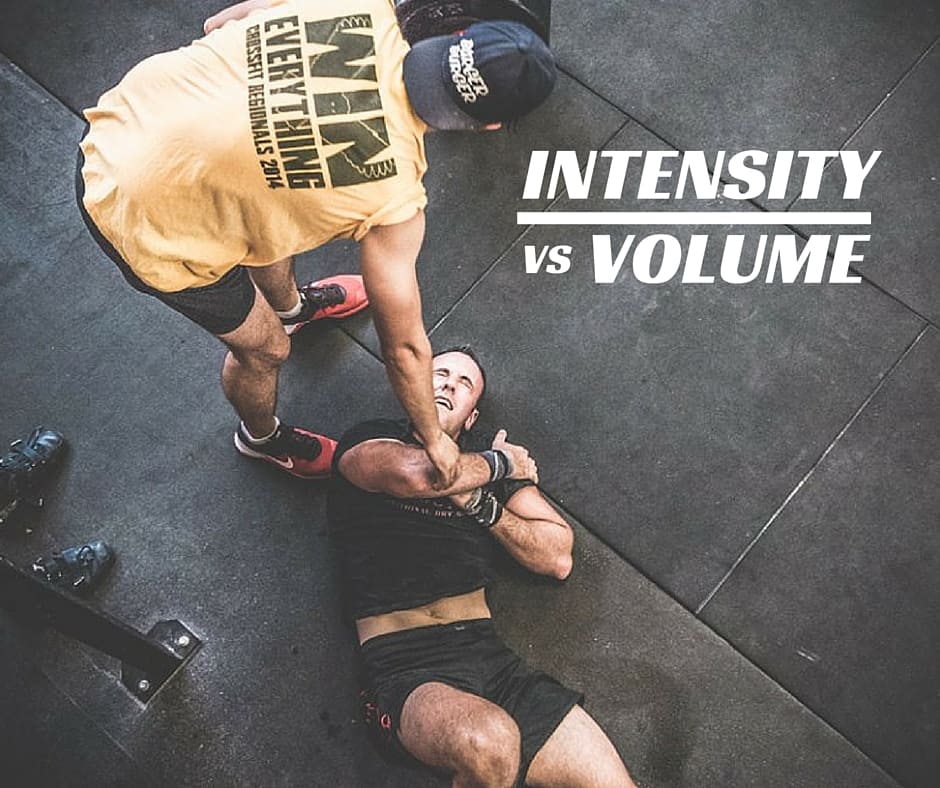

The CrossFit program is built around founder Greg Glassman’s mantra of “World Class Fitness in 100 Words” which includes the central point: “keep workouts short and intense.” Any CrossFit gym owner will tell you that in the pursuit of general physical preparedness (GPP) for the general population, intensity and variance are key.
With that in mind, why do we often see training programs piling workout upon workout for a 90 minute to 2-hour training session? In reality these programs are not designed for those who simply want to get fit. They are designed for those who want to qualify for Regionals or for the overzealous “weekend competition warrior”. That’s not to say that volume doesn’t have its place. Firstly, volume is necessary for recovery adaptation, which in turn allows you to recover faster from workout intensity. In other words, at a local competition that may comprise of 4-5 workouts in one day, training volume allows you to recover better between each event and hit each of those 4-5 workouts with greater intensity.
Secondly, volume allows athletes to work on multiple areas of fitness in one session (providing intensity and/or quality can be maintained). However, as many of you know, volume comes at the cost of recovery. It becomes physically and mentally challenging to maintain intensity when volume is increased. Herein lies another benefit of volume, demanding intensity when you are physically and mentally fatigued teaches you how to perform when you are not fresh – for instance; on the final workout of a two-day competition.
Despite the potential benefits to increased training volume, mindlessly cramming workout upon workout in pursuit of fitness goals can end up stalling progress or invite injury. The most pig-headed athletes can compromise their recovery and eventually push themselves into the dreaded ‘overtraining’ zone, which often brings a regression in athletic performance. Increased volume demands more sleep, precise nutritional habits that support performance, an injury prevention routine (massage, chiropractic work, mobility, etc.) and good communication with a coach. It’s also important to ensure that volume does not come at the expense of intensity.
So, in theory volume can help athletes achieve success in CrossFit as a sport, but it should be implemented safely and systematically. This is absolutely something that should be discussed with your CrossFit coach before jumping into.
For affiliate owners looking to add more volume into their classes, it’s important to remember that the majority of your members and thus the majority of your income, comes from members who are training for life. A one-hour session four to five times a week which consists of a warm up, strength piece or skill work, conditioning, and a cool down will be more than enough to obtain fitness for life. Trying to cram more into a one-hour CrossFit class makes it more difficult to meet your member’s needs. Don’t forget these needs include correcting, cueing and improving their movement, not simply starting the clock and saying ‘3-2-1-GO’. As six time CrossFit Games athlete James Hobart says, “volume is not the cure-all; effective coaching is.”.
For athletes looking to add more volume into their training, it’s crucial that they have a base of mechanical proficiency in the foundational movements and they are consistent in their approach to intensity. If you struggle with basic mechanics in movements such as the squat or with overhead mobility, then volume isn’t the solution for you. Doing workout after workout is not a shortcut to fitness. If you lack good mechanics, it’s a shortcut to the reinforcement of poor movement. The more you practice poor movement the better you will get at poor movement. Top athletes strive for perfect mechanics in foundational movement and have an established training history that allow them to increase their training volume.
For most of us, intensity is where the magic happens. As games athlete and good friend Pat Barber would say, “find that dark place in a workout and push further until you find an even darker place.” Intensity reigns king in CrossFit and this is what separates CrossFit from the majority of other fitness programs. It’s what drives change and produces results. Volume can certainly be used to gain the upper hand in the sport of CrossFit but it should not be added at the cost of intensity. As a coach you should know what people in your gym train for. If it’s training for life, then there is no need for pure volume. This group will improve work capacity across broad time and modal domains with constantly varied functional movements executed at high intensity during once-a-day sessions, four to five times per week. Those who are looking to compete and have a solid base of mechanics as well as consistency and hit their workouts with high intensity, can then begin to look at a structured approach of increased volume in their training.
-Daniel Rankin (Head Coach, Andfit CrossFit)
References
Laursen, P. B. (2010). Training for intense exercise performance: high‐intensity or high‐volume training?. Scandinavian journal of medicine & science in sports, 20(s2), 1-10.
Gibala, M. J., Little, J. P., MacDonald, M. J., & Hawley, J. A. (2012). Physiological adaptations to low‐volume, high‐intensity interval training in health and disease. The Journal of physiology, 590(5), 1077-1084.
Hobart, J. (2016, March 18). A Deft Dose of Volume. Retrieved from http://journal.crossfit.com/2016/03/a-deft-dose-of-volume.tpl

